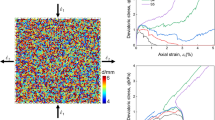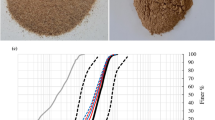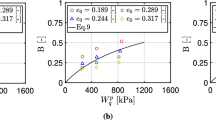Abstract
Discrete numerical simulations were carried out to reproduce experimental results obtained on loose cohesionless soil samples subjected to triaxial tests. Periodic boundary conditions were adopted and 3D spherical discrete elements were chosen. However, to overcome excessive rolling of such an oversimplified particle’s shape, contact rolling resistance was taken into consideration. The influence of both the elastic and the plastic local parameters is discussed. It is shown that the plastic macroscopic behavior of the granular assembly depends only on the plastic parameters at the microscopic scale, and mainly on the plastic rolling moment reflecting the particle’s shape. Moreover, a procedure to obtain an initial density, ranging from loose to dense samples, is proposed by adding adhesion at contacts during the preparation phase. Finally, a calibration procedure is proposed to reproduce experimental results and the limitations of the model are discussed.












Similar content being viewed by others
References
Bardet, J.P.: Observations on the effects of particle rotations on the failure of idealized granular materials. Mech. Mater. 18(2), 159–182 (1994)
Benahmed, N., Nguyen, T.K., Hicher, P.Y., Nicolas, M.: An experimental investigation into the effects of low plastic fines content on the behaviour of sand/silt mixtures. Eur. J. Environ. Civil Eng. 19(1), 109–128 (2015)
Brauer, A., Mewborn, A.C.: The greatest distance between two characteristic roots of a matrix. Duke Math. J. 26(4), 653–661 (1959)
Calvetti, F., Viggiani, G., Tamagnini, C.: A numerical investigation of the incremental behavior of granular soils. Riv. Ital. Geotech. 3, 11–29 (2003)
Chareyre, B., Briançon, L., Villard, P.: Theoretical versus experimental modeling of the anchorage capacity of geotextiles in trenches. Geosynth. Int. 9(2), 97–123 (2002)
Chareyre, B., Villard, P.: Dynamic spar elements and discrete element methods in two dimensions for the modeling of soil-inclusion problems. J. Eng. Mech. 131(7), 689–698 (2005)
Combe, G.: Origines géométrique du comportement quasi-statique des assemblages granulaires denses: étude par simulations numériques. PhD thesis, Ecole nationale des ponts et chaussées (2001)
Cundall, P.A., Strack, O.D.L.: A discrete numerical model for granular assemblies. Géotechnique 29(1), 47–65 (1979)
da Cruz, F., Emam, S., Prochnow, M., Roux, J.-N., Chevoir, F.: Rheophysics of dense granular materials: discrete simulation of plane shear flows. Phys. Rev. E 72, 021309 (2005)
Estrada, N., Azéma, E., Radjaï, F., Taboada, A.: Comparison of the effects of rolling resistance and angularity in sheared granular media. Powder Grains hal–00842799, 891–894 (2013)
Gilabert, F., Roux, J.-N., Castellanos, A.: Computer simulation of model cohesive powders: influence of assembling procedure and contact laws on low consolidation states. Phys. Rev. E 75, 011303 (2007)
Hart, R., Cundall, P.A., Lemos, J.: Formulation of a three-dimensional distinct element model-part II. Mechanical calculations for motion and interaction of a system composed of many polyhedral blocks. Int. J. Rock Mech. Min. Sci. Geomech. Abstr. 25(3), 117–125 (1988)
Huang, X., Hanley, K.J., O’Sullivan, C., Kwok, C.K.: Exploring the influence of interparticle friction on critical state behavior using DEM. Int. J. Numer. Anal. Meth. Geomech. 38(12), 1276–1297 (2014)
Itasca Consulting Group. PFC3D Theory and Background Manual, version 3.0. Itasca Consulting Group, Monneapolis, Minnesota, USA (2003)
Iwashita, K., Oda, M.: Micro-deformation mechanism of shear banding process based on modified distinct element method. Powder Technol. 109(1–3), 192–205 (2000)
Jiang, M.J., Konrad, J.M., Leroueil, S.: An efficient technique for generating homogeneous specimens for DEM studies. Comput. Geotech. 30(7), 579–597 (2003)
Kozicki, J., Tejchman, J.: Numerical simulations of sand behaviour using DEM with two different descriptions of grain roughness. In: II International Conference on Particle-Based Methods—Fundamentals and Applications, Particles (2011)
Kozicki, J., Tejchman, J., Leśniewska, D.: Study of some micro-structural phenomena in granular shear zones. In: AIP Conference Proceeding of Powder and Grains, vol. 1542 (2013)
Lee, S.J., Hashash, Y.M.A., Nezami, E.G.: Simulation of triaxial compression tests with polyhedral discrete elements. Comput. Geotech. 43, 92–100 (2012)
Nguyen, T.K.: Etude expérimentale du comportement instable d’un sable silteux: application aux digues de protection. PhD thesis, Université d’Aix-Marseille (2014)
Oda, M., Iwashita, K.: Study on couple stress and shear band development in granular media based on numerical simulation analyses. Int. J. Eng. Sci. 38(15), 1713–1740 (2000)
Oda, M., Konishi, J., Nemat-Nasser, S.: Experimental micromechanical evaluation of strength of granular materials: effects of particle rolling. Mech. Mater. 1(4), 269–283 (1982)
Plassiard, J.-P., Belheine, N., Donzé, F.-V.: A spherical discrete element model: calibration procedure and incremental response. Granul. Matter 11(5), 293–306 (2009)
Radjaï, F., Dubois, F.: Discrete-Element Modeling of Granular Materials. ISTE/Wiley, London (2011)
Roux, J.-N., Chevoir, F.: Discrete numerical simulation and the mechanical behavior of granular materials. Bulletin des laboratoires des ponts et chaussées 254, 109–138 (2005)
Roux, J-N., Combe, G.: How granular materials deform in quasistatic conditions. In: IUTAM-ISIMM Symposium on Mathematical Modeling and Physical Instances of Granular Flow. AIP Publishing, vol. 1227(1), pp. 260–270, (2010)
Salot, C., Gotteland, P., Villard, P.: Influence of relative density on granular materials behavior: DEM simulations of triaxial tests. Granul. Matter 11(4), 221–236 (2009)
Scholtés, L., Chareyre, B., Nicot, F., Darve, F.: Micromechanics of granular materials with capillary effects. Int. J. Eng. Sci. 47(11–12), 1460–1471 (2009)
Suhr, B., Six, K.: On the effect of stress dependent interparticle friction in direct shear tests. Powder Technol. 294, 211–220 (2016)
Szarf, K., Combe, G., Villard, P.: Polygons vs. clumps of discs: a numerical study of the influence of grain shape on the mechanical behaviour of granular materials. Powder Technol. 208(2), 279–288 (2011)
Šmilauer, V., et al.: Yade Documentation, 2nd edn. The Yade Project (2015). http://yade-dem.org/doc/
Thornton, C.: Numerical simulations of deviatoric shear deformation of granular media. Géotechnique 50(1), 43–53 (2000)
Ting, J.M., Corkum, B.T., Kauffman, C.R., Greco, C.: Discrete numerical model for soil mechanics. J. Geotech. Eng. 115(3), 379–398 (1989)
Tong, A.-T., Catalano, E., Chareyre, B.: Pore-scale flow simulations: model predictions compared with experiments on bi-dispersed granular assemblies. Oil Gas Sci. Technol. Rev. IFP Energ. Nouv. 67(5), 743–752 (2012)
Wang, X., Li, J.: Simulation of triaxial response of granular materials by modified DEM. Sci. China Phys. Mech. Astron. 57(12), 2297–2308 (2014)
Widuliński, L., Kozicki, J., Tejchman, J.: Numerical simulations of triaxial test with sand using DEM. Arch. Hydro Eng. Environ. Mech. 56(3–4), 149–171 (2009)
Acknowledgements
The environment and support provided by the French research group GDR MeGe 3176 is gratefully acknowledged.
Laboratory 3SR is part of the LabEx Tec 21 (Investissements d’Avenir—Grant Agreement No. ANR-11-LABX-0030).
Author information
Authors and Affiliations
Corresponding author
Appendix
Appendix
Let \(\vec {u}\), \(\vec {\theta }\) define small movements of a particle relative to an initially stable configuration in which the total force and torque on the particle are \(\vec {F}=\vec {T}=\vec {0}\). If the particle is involved in \(N_c\) contacts and every contact remains elastic (worst case), the new force and torque induced by \(\vec {u}\) and \(\vec {\theta }\) can be expressed as follows, in which the translational and the rotational degrees of freedom are uncoupled (this uncoupling assumption is also found in [14]): (Note that since \(\vec {F}=\vec {T}=\vec {0}\), then we can write \(\varDelta \vec {F}=\vec {F}\) and \(\varDelta \vec {T}=\vec {T}\)):
\(\mathbf{I}\) being the inertia tensor of the particle and r its radius. These forces are given by neglecting the rotational term in Eq. 12 and the translational term in Eq. 13.
If contact moments (\(\vec {M}_r\) and \(\vec {M}_{\textit{tw}}\)) are present, the moments (initially null) induced at each contact (remaining elastic) by \(\vec {u}\) and \(\vec {\theta }\) are:
where \(K_r\) and \( K_{\textit{tw}}\) are the rolling and twisting stiffnesses, respectively. Note that, in our study, only the rolling moment was taken into consideration. However, for generalization, we added the twisting moment here.
Adding these contributions (Eqs. 14 and 15) to the global rotational stiffness (Eq. 13) yields
The uncoupled equations of motion for the particle can be expressed as:
where \(\mathbf{K}_u\) and \(\mathbf{K}_\theta \) are the tensors defined by Eqs. 12 and 16 respectively, M is the mass of the particle, and J is the moment of inertia (equal to \(\frac{2}{5}r^2 M\) for a sphere).
\(\frac{\mathbf{K}_u}{M}\) and \(\frac{\mathbf{K}_\theta }{J}\) are symmetric positive definite tensors from which six eigen values can be calculated, corresponding to six natural frequencies of the particle. The explicit centered finite difference scheme is stable for the above equations—for a single particle b—as long as \(\varDelta t\) is less than \(2/\sqrt{\lambda ^b_{\textit{max}}}\), \(\lambda ^b_{\textit{max}}\) being the maximum eigenvalue of the particle.
A multi-body system as a whole may have natural oscillation modes combining the motion of multiple particles, with frequencies higher than the maximum frequency found for individual particles. An accurate determination of the critical timestep would thus need to consider the stiffness matrix of the system as a whole where the motion of two particles in contact would be included. For \(N_b\) particles it would lead to a matrix of size \((6N_b)^2\) from which eigenvalues would have to be extracted. It can be avoided by remarking that this large assembled matrix would have every contact stiffness appearing twice in each row (once in the diagonal term and once in the column whose index corresponds to the other particle forming the contact). Since the absolute row-sum of the components can be used as an upper bound of the maximum eigenvalue (Perron-Froebenius theorem [3]) an upper bound is obtained simply by multiplying every stiffness by two when calculating the frequencies of one single particle. Equivalently, we can keep the stiffness unchanged and define the upper bound using the eigenvalues associated to individual particles as
[12] suggested a similar inequality without proof. Finally, a sufficient condition of stability is:
The equations of motion for a particle, (17) and (18), can be written in a simplified way considering the following assumptions:
-
1.
all spheres are identical (same size and same inertia)
-
2.
all contacts have the same stiffness values
-
3.
the stiffness tensors, defined by Eqs. 12 and 16, are isotropic.
We note also that \(K_r =\alpha _{rn}r^{2}K_n\) and \(K-{\textit{tw}} = \alpha _{\textit{tw}}r^{2}K_n\). Then the uncoupled equations of motion read:
Rights and permissions
About this article
Cite this article
Aboul Hosn, R., Sibille, L., Benahmed, N. et al. Discrete numerical modeling of loose soil with spherical particles and interparticle rolling friction. Granular Matter 19, 4 (2017). https://doi.org/10.1007/s10035-016-0687-0
Received:
Published:
DOI: https://doi.org/10.1007/s10035-016-0687-0




